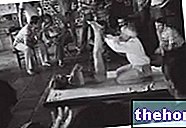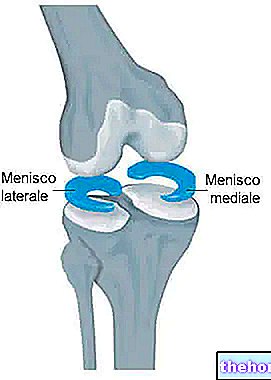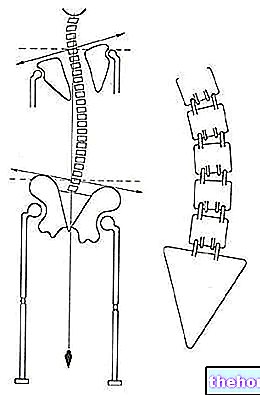Operate, not operate, totally remove or suture? These are the most frequent questions that the doctor and the patient ask themselves following a meniscal tear




FOREWORD: The meniscus is devoid of blood vessels except for its two ends. In young adults this vascular system penetrates inside the medial meniscus for about 10-30% of its length, while in the lateral one the penetration is slightly less (10-25%). It follows that, except for small peripheral lesions , in case of a strong trauma its reparative capacities are extremely low.
Conservative treatment
The initial treatment of meniscal tears follows the classic R.I.C.E (rest, ice, compression and elevation) protocol. According to these rules, the injured limb must first of all be immobilized and put to rest. Ice will then be applied to the injured area (four or five daily applications for 10-15 minutes in the 24-48 hours following the trauma). Cryotherapy associated with rest, it will thus help reduce swelling and local pain.
If the person is young, particularly lucky, and if the knee is stable and there are no signs of joint blockage, conservative treatment may be sufficient for complete healing of the injured meniscus.
If, on the other hand, a fragment of mobile meniscus is present inside the joint, surgical removal is absolutely necessary.
Degenerative injuries, that is, which occur without a significant traumatic event, instead require a waiting period. Thanks to the movements it can in fact happen that these meniscal fraying are filed, making the pain disappear.
It is therefore important that the patient arms himself with good patience and endures local discomfort and pain for a few months.
SPECIAL CASE: if the meniscus breaks, but the fragment does not interpose itself between the joint heads, when the hydrarthrosis is reabsorbed or is aspirated with a syringe (ARTHROCENTHESIS), the knee behaves as a healthy joint (pseudo healing).
From pseudo healing one returns to clinical disease if due to a movement, even a trivial one, the broken meniscus flap is again interposed between the femoral condyle and the tibial plateau (climbing stairs, walking on uneven ground, etc.). The classic symptoms of meniscal tear will recur and the patient returns to the doctor complaining of pain, hydrarct and functional limitation.
PHYSICAL THERAPIES: meniscal tears, with rare exceptions, are curable only through surgery. Consequently, physical therapy cannot have any effect on meniscus repair. However, it can act by reducing pain and relieving symptoms. After the acute phase of trauma, heat can for example be useful to combat local stiffness.
Infiltrations with high molecular weight hyaluronic acid can instead help the cartilage to better withstand joint stress after total meniscectomy. These infiltrations also favor the functionality of the joint by lubricating the two bone heads and nourishing the cartilage.
Surgical treatment
INTRODUCTION: Once upon a time the menisci were considered important but not indispensable and were therefore removed in case of injury. Although in the short term these interventions quickly restored lost joint function, some subsequent studies showed a profound incidence of osteoarthritis and degenerative diseases in patients who had undergone this surgery (meniscectomy).
Today the old techniques have been almost completely replaced by arthroscopic surgery which, if the injury makes it possible, does not remove but sutures the damaged part of the meniscus. A succession of numerous studies has in fact clearly demonstrated that the preservation of the meniscus protects the articular cartilage from degenerative processes and that these are directly proportional to the portion of the meniscus removed.
Surgical treatment has the possibility of:
suture the meniscal lesion, promoting healing and spontaneous regeneration
remove only the part of the injured meniscus (selective meniscectomy)
completely remove the torn meniscus (meniscectomy)
As seen in the introductory part, in some particular situations of both traumatic and degenerative origin, the meniscus has a certain ability to repair itself. This characteristic is directly related to the local vascularization: the greater the blood flow, the greater the chances of recovery.
The suturing operation exploits these principles by stitching up the lesion and promoting spontaneous regeneration. The most suitable area for this treatment is the peripheral one. The suturing operation is performed under arthroscopy and has a much lower risk of medium and long-term complications. compared to meniscectomy procedures. However, the operation involves rather long recovery times and forces the subject to four weeks of crutches and a few months of rehabilitation before resuming physical activity. In any case, this is a long-term investment, since meniscal suturing, if indicated and well performed, greatly reduces the risk of long-term cartilage degeneration.
Importance of the menisci
The removal of even just parts of the meniscus alters the normal joint relationships of the knee causing, in the long run, degenerative phenomena that lead to a self-consumption of the cartilage (arthrosis).
It is clearly demonstrated that keeping, as far as possible, a stable and balanced meniscus protects the cartilage from further overloads and degenerative processes.
In particular, some studies have shown that every year following the total removal of the menisci leads to the loss of 6.5% of the total cartilage volume. For this reason, if the removal is really necessary, it must be as selective as possible, saving the part of the meniscus remained intact.
Once the need for surgery has been established, thanks to arthroscopy, the surgeon will be able to see the state of health of the menisci, removing the injured piece of meniscus using small instruments.
MENISCAL TRANSPLANT from deceased donors (allograft): it is indicated in patients who have had a total removal of the meniscus and begin to experience pain while still having intact joint surfaces. In the United States, this type of surgery is quite widespread and good results have been reported clinically.
However, it must be considered that the transplanted meniscus will be slightly different from the one that mother nature has endowed us with. This slightly affects the functionality of the joint while ensuring good mobility and significantly reducing the risk of osteoarthritis.
Today it is also possible to replace the removed part of the meniscus with a special collagen implant that will promote healing by stimulating the regenerative capacity of the meniscus.
PREPARATION FOR SURGICAL INTERVENTION: to ensure a faster recovery after surgery, it is essential that patients waiting for surgery exercise the muscles of the anterior part of the thigh on a daily basis.
Quadriceps isometric contractions: sit on the ground, with the injured leg extended and close to the ground, the other bent. Push the injured knee towards the ground by contracting the quadriceps (anterior thigh muscle). Hold for 10 seconds, relax and repeat 3 times
Extensions of the lower limb: sitting on the ground, with the injured leg extended and close to the ground, the other bent. Contract the quadriceps muscles to raise the injured limb 20 cm while keeping the knee fully extended. Hold the position for 10 seconds, relax and repeat 3 times
Obviously, these exercises should be performed only after consulting the doctor as in particular situations they could be contraindicated.
CONTINUES: rehabilitation after meniscal injury "




























